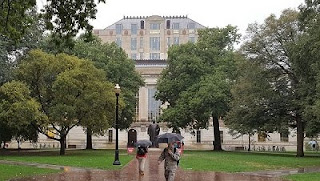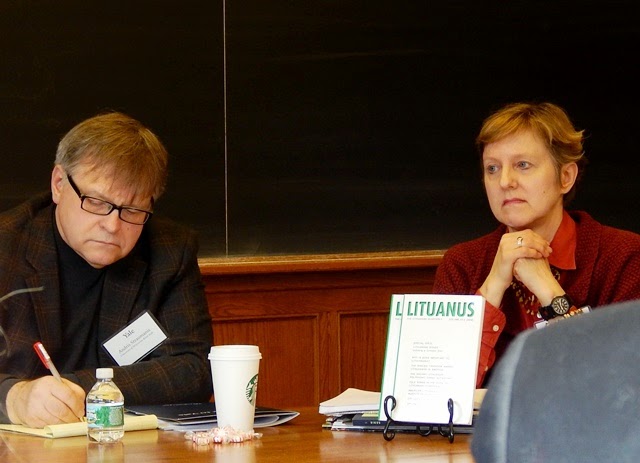After attending the USETDA conference in Columbus, OH, I took the opportunity to visit the main library at Ohio State University, which got a major award-winning renovation in 2009. It was a rainy day, so I came in from the Oval, the only entrance I knew, so my photo of the outside is not impressive. You can see the other side with the new addition on the ALA award site.
 As I walked in there was a stand of plastic bags for umbrellas - a nice touch. When I walked into the very open space with visible stacks and various help stations and student study areas around me, I was happy to see a pillar with “Where is it?” and a “Welcome” sign. I was actually going to look for the bathrooms and hated to ask, so was happy that both signs explained where they were on each floor.
As I walked in there was a stand of plastic bags for umbrellas - a nice touch. When I walked into the very open space with visible stacks and various help stations and student study areas around me, I was happy to see a pillar with “Where is it?” and a “Welcome” sign. I was actually going to look for the bathrooms and hated to ask, so was happy that both signs explained where they were on each floor. The first floor had (going counterclockwise from the entrance): Circulation and Reserves; Leisure Reading; Reference & Assistance (talked to the Ref. Librarian about the changes, they are at the desk for a few busiest hours each day); Copy, Scan, Assemble; Current Periodicals (not too many, but more than we have); Computer Lab, Multipurpose Room (had seating for about 50 for a presentation, but students were using it as study space); Media; Gallery; and Special Collections Displays. The lower level, which only covers half the footprint has group study rooms, the cafe and Buckeye Bar, which is there for IT support. They have group study rooms that can be reserved online throughout the building, but not as many as I would have expected, maybe because there is such a variety of study space available. The lower floors are meant for collaboration and the higher you go, the quieter it is supposed to get.
The first floor had (going counterclockwise from the entrance): Circulation and Reserves; Leisure Reading; Reference & Assistance (talked to the Ref. Librarian about the changes, they are at the desk for a few busiest hours each day); Copy, Scan, Assemble; Current Periodicals (not too many, but more than we have); Computer Lab, Multipurpose Room (had seating for about 50 for a presentation, but students were using it as study space); Media; Gallery; and Special Collections Displays. The lower level, which only covers half the footprint has group study rooms, the cafe and Buckeye Bar, which is there for IT support. They have group study rooms that can be reserved online throughout the building, but not as many as I would have expected, maybe because there is such a variety of study space available. The lower floors are meant for collaboration and the higher you go, the quieter it is supposed to get.
The stacks are in the tower in the center of the building. What they did there was to open it up with glass walls, so you can literally see through from one side of the building to the other. Staff offices are along the edges of the building. One area was for subject librarians, another for copyright resources.
On the very top floor – the 11th, there was a wonderful wood paneled study space that is also used for special occasions with views of the Oval on one side and the stadium and medical center on the other. Since I worked at the OSU hospital for a year in the 1970’s, that was of more interest than the football stadium.
I liked their wall of presidential portraits. I know that we have Dwight B. Waldo, but there is more to our history. It would be nice to have all of them someplace. They even had photos of all the directors of the libraries. They do have 13 libraries, though some have been consolidated into Thompson and the 18th Avenue Library, which houses their latest renovation – a Research Commons. The day was just too nasty to go over there and I wanted to get on the road home.

 I picked up most of their brochures – the guide to the Thompson library, LC classification explained, printing at the library, Graduate Students and University Libraries, Fair Use, Copyright in Your Thesis or Dissertation, an extensive newsletter from Spring, Student Technology Resources (an IT publication), and an explanation of floor inlays and elevator etchings they call Foundation Stones. I noticed these interesting scripts or alphabets on the floor, turns out that there “are 49 metal tablets documenting forms of written communication from around the world”, and even more in the etchings on the elevator doors. Anything from Aztec to Etruscan to Rongorongo of Easter Island and the Elvish script invented by J.R.R. Tolkien.
I picked up most of their brochures – the guide to the Thompson library, LC classification explained, printing at the library, Graduate Students and University Libraries, Fair Use, Copyright in Your Thesis or Dissertation, an extensive newsletter from Spring, Student Technology Resources (an IT publication), and an explanation of floor inlays and elevator etchings they call Foundation Stones. I noticed these interesting scripts or alphabets on the floor, turns out that there “are 49 metal tablets documenting forms of written communication from around the world”, and even more in the etchings on the elevator doors. Anything from Aztec to Etruscan to Rongorongo of Easter Island and the Elvish script invented by J.R.R. Tolkien.
Lots of ideas for consideration for our own renovation.




























